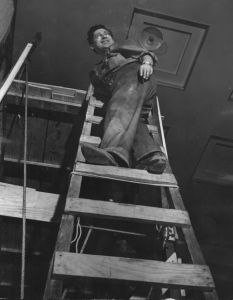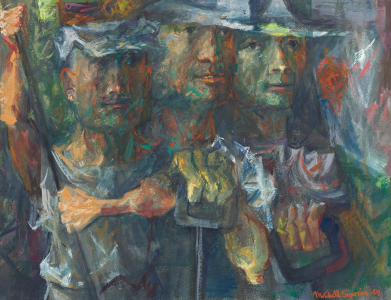
Biography
Mitchell Siporin, the child of recent Jewish immigrants from Poland, was born in New York in 1910. His family soon moved to Chicago, where he was raised, speaking only Yiddish until he was 6. Legend has it that his artistic abilities were first recognized in a botany class, where his skillful drawings gained him the title "Mitchell Siporin, the artist."
After attending Crane College (now Malcolm X College) on the Near West Side of Chicago, Siporin enrolled at the School of the Art Institute. He also took private lessons from Todros Geller, a renowned printmaker whose work focused on the Jewish tradition.
In the early 1930s Siporin found work as a freelance illustrator and cartoonist, with drawings that appeared in Esquire, New Masses and Ringmaster magazines. Of particular note were a series of 25 drawings of the Haymarket Incident (a Chicago labor protest in 1886). This work was a good preparation for the federally-sponsored murals that would follow.
Siporin's egg tempera work "Let America Be America Again" (1936) was developed in collaboration with Langston Hughes and reproduced in Esquire with the text of the Hughes poem. Early mural commissions included Bloom Township High School (1935) and Lane Tech High School (1938). There followed commissions for Post Offices in Decatur, IL (1938) and St. Louis, MO (1942). The latter, undertaken in collaboration with Edward Millman, was the largest of the awards given by the Treasury Department Section of Fine Arts.
In 1943 Siporin enlisted in the Army, seeking to serve as a war artist. He was sent to Italy, then North Africa in this role. After the War he married Miriam Tane in Manhattan, received two Guggenheim Fellowships (1945, 1947), and was awarded the Prix de Rome in painting in 1949.
Siporin's academic career began in 1951 at Brandeis University, where he founded the art department. He was the first curator of the Brandeis University Art Collection, and he taught at Brandeis until his death in 1976.


Critical Analysis
Siporin's style was Social Realism, and his work produced some of the greatest examples of that style. The figures in his paintings often represent oppressed people, and they are portrayed with sympathy and strength.
Murals
- Chicago, Illinois - Lane Tech College Prep High School Auditorium: Teaching of the Arts
- Decatur, Illinois - Post Office: The Fusion of Agriculture and Industry
- St Louis, Missouri - Post Office: Discovery and Colonization
- St Louis, Missouri - Post Office: George Rogers Clark and Daniel Boone
- St Louis, Missouri - Post Office: The Civil War
- St Louis, Missouri - Post Office: The Post War Period -- Reconstruction
References
- Brianna Dang, The man behind the murals, The Warrior December 22 A&E (2016). Article from the student news site of Lane Tech College Prep about Mitchell Siporin and the murals at the Lane Auditorium.
- Mitchell Siporin (Modernism in the New City: Chicago Artists, 1920-1950). Biographical text by Daniel Schulman for an art collection selected by Bernard Friedman.
- Mitchell Siporin (Wikipedia).
- Mitchell Siporin (Smithsonian American Art Museum).